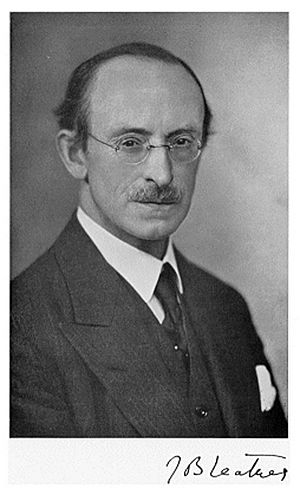John Beresford Leathes facts for kids
John Beresford Leathes (born November 5, 1864 – died September 14, 1956) was an important British scientist. He was a physiologist, which means he studied how living things work, and an early biochemist, meaning he looked at the chemistry of living things. He earned many important degrees and titles, like Doctor of Science (DSc) and was a Fellow of the Royal Society, a famous group of scientists. His father was a scholar of the Hebrew language, and his brother was a well-known poet and historian.
Growing Up
John Beresford Leathes was born in 1864. His father, Reverend Stanley Leathes, taught Hebrew at King's College London. His mother, Matilda, came from a family that included a doctor who worked for King Henry VIII. John's older brother, Stanley Mordaunt Leathes, became a famous poet and historian.
John went to Winchester College from 1878 to 1883. This school focused on Classics, like ancient Greek and Latin. It didn't have many science classes back then. When a famous politician, William Ewart Gladstone, visited the school, John gave a welcome speech to him in Latin.
Becoming a Doctor
In 1884, John went to New College, Oxford to study Classics. He earned a good degree there. His father wanted him to become a priest, but John decided to study medicine instead. He went to Guy's Hospital in London. He was very dedicated, walking 12 miles each day to get to the hospital and back home.
He became a qualified doctor in 1893. The next year, he passed another important exam to become a Fellow of the Royal College of Surgeons. John helped teach Anatomy and Physiology at Guy's Hospital. He couldn't become a surgeon himself because his eyesight wasn't good enough. In 1895, he joined The Physiological Society, a group for scientists who study how bodies work.
From 1895 to 1899, John studied in other countries, first in Berne and then in Strasbourg. He learned from famous scientists there, like Oswald Schmiedeberg. When he came back to London in 1899, he became a teacher of Physiology at St Thomas's Hospital Medical School. He also worked part-time at the Lister Institute for about eight years.
A Career in Science
In 1909, John became a leader in The Physiological Society. But he had to leave that role when he moved to Canada later that year. He was asked to start a new department at the University of Toronto called Pathological Chemistry. This meant studying the chemistry of diseases.
In Toronto, he helped create a local Medical Research Society. In 1912, a new building opened at the Toronto General Hospital. John set up special labs there for students who wanted to learn and do research in chemical medicine. He stayed in Toronto until 1914.
Then, he returned to the UK to become a Professor of Physiology at the University of Sheffield. He also served twice as the Dean of the Faculty of Medicine there.
During World War I, John helped care for soldiers with kidney problems at the Northern General Hospital in Sheffield. He also helped set up special labs for chemistry in the city's two main hospitals in 1919. He represented Sheffield University on the General Medical Council from 1919 to 1938. For ten years, he was an editor for The Journal of Physiology, a scientific magazine. John retired from Sheffield in 1933.
In 1911, John was chosen as a Fellow of the Royal Society, which is a very high honor for scientists. In 1921, he became a Fellow of the Royal College of Physicians of London. He gave important lectures there, including the Croonian Lecture in 1923 and the Harveian Oration in 1930. He also received honorary science degrees from the University of Manchester and the University of Sheffield.
After retiring, John moved around. He worked for a short time at the University of Oxford in a physiology lab. But this work stopped when World War II began in 1939. He then moved to different places in England before finally settling in Montreux, Switzerland, after the war. He passed away there in September 1956, at the age of 92.
His Family
John married Sonia Marie Natanson in London in 1896. She was from Russia. Their daughter, Margaret Leathes, married Lionel Penrose in 1928. Lionel was a Professor of Genetics at University College, London.
Margaret and Lionel had several children who became famous in their own fields:
- Oliver Penrose, a theoretical physicist.
- Sir Roger Penrose, a mathematical physicist who won a Nobel Prize.
- Jonathan Penrose, a chess player.
- Shirley Hodgson, a geneticist.


